Reference no: EM133006698
Dimensional Analysis & Hydraulic Machines
Learning Outcome 1: Personal & Transferable Skills
1 Demonstrate numerical skills in the calculation of static and dynamic fluid systems.
Research, Knowledge & Cognitive Skills
2 Describe and explain the principles and application of hydraulic machines.
3 Analyse static and fluid flow systems.
Professional Skills
4 Apply the theory of viscosity in fluids to engineering situations.
Question 1 A horizontal pipe is filled with liquid. When the liquid is stationary, its head H metres depends on the pressure p of the liquid, its density ρ and gravitational acceleration g. Determine the nature of the relationship of these variables.
Question 2 (a) Water (density 1000 kg m-3) is maintained at a gauge pressure of 4.5 MPa in a horizontal pipe of diameter 120 mm. It is passed through a nozzle of diameter 16 mm which discharges a horizontal jet into the atmosphere. If the frictional losses reduce the theoretical discharge velocity by 7% in this process, calculate the actual velocity of the jet and its flowrate in kgs-1.
(b) This jet strikes an upward curved vane moving at 20 ms-1 in a horizontal direction away from the jet, which deflects the water through an angle of 115º. The impact is shockless. Calculate:
(i) the magnitude and direction of the velocity of the fluid leaving the vane;
(ii) the thrust on the vane in a horizontal direction;
(iii) the thrust on the vane in a vertical direction;
(iv) the power generated by the impact in the horizontal direction.
Question 3 (a) Distinguish, with the aid of simple sketches where appropriate, between the construction, operation and applications of the Pelton wheel, Francis turbine and Kaplan turbine.
(b) In a Francis turbine, the supply head H is 25 m of water (density 1000 kgm-3). The discharge rate to atmosphere is 700 kgs-1. The external radius of the runner R1 is 0.48 m and the internal radius R2 is
0.22 m. The runner blades are radial at inlet and rotate at 320 revs per min. The blades occupy 6% of the circumferential area and are shaped to ensure that the radial velocity u1R is kept constant and equal to
0.2√2gh . If the shaft power is 75% of the water power, determine the:
(i) guide vane angle;
(ii) blade exit angle;
(iii) water power;
(iv) diagram power;
(v) shaft power;
(vi) height of runner blade at inlet and outlet.
Question 4 A centrifugal pump has the following pressure - capacity characteristics:

It is planned to use this for a process having the following system characteristic:

(a) Determine the operating point for this pump with this system.
(b) The actual flowrate required by the process is 75 m3h-1. If the overall efficiency of the pump at this flowrate is 70%, determine the power consumed when the liquid being pumped has a density of 1250 kgm-3.
(c) A second pump is available which has the following characteristics:

For the same flowrate (75 m3h-1), this pump has an overall efficiency of 75%.
(i) Determine the power used by this pump at a flowrate of 75 m3h-1.
(ii) Would it be a better choice? Give reasons for your answer.
(iii) What other factors should be considered before a final choice is made?
Question 5 A process requires the precise control of the flow of a fluid to a reactor operating at 100 bar pressure (1 bar = 100 kPa). The flowrate may need to change to match the required reactor output. The flow should be relatively non-pulsating.
(a) Suggest a suitable pump for this duty. Give reasons for your choice.
(b) Describe, with the aid of a suitable diagram, the construction and operation of your chosen pump.
Question 6 It is proposed to pump 1600 m3 of a liquid (density 1100 kgm-3) each day through a total head of 12 m (including all losses) by using either a centrifugal or a reciprocating pump.
The centrifugal pump has a discharge rate of 1.8 m3min-1 when driven by an electric motor supplying a power of 4.75 kW.
The reciprocating pump discharges 2.0 m3min-1 when driven by an electric motor supplying 5 kW.
(a) Calculate the efficiency of each pump.
(b) If electricity costs 16p per kWh, select the most economical pump and determine the cost saving over 100 days of operation.
(c) State two other factors which should be considered before a final choice of pump is made.
Fluid Mechanics Static & Dynamic Fluid Systems
Learning Outcomes
Personal & Transferable Skills
1 Demonstrate numerical skills in the calculation of static and dynamic fluid systems.
Research, Knowledge & Cognitive Skills
2 Describe and explain the principles and application of hydraulic machines. 3 Analyse static and fluid flow systems.
Professional Skills
4 Apply the theory of viscosity in fluids to engineering situations.
Question 1 Compare liquids and gases with regard to their:
• shape
• volume occupied
• density
• viscosity
• compressibility
Question 2 (a) Define dynamic viscosity and give the mathematical formula for Newton's law of viscosity.
(b) How does kinematic viscosity differ from dynamic viscosity?
(c) Explain why viscosity is an important property in Fluid Mechanics.
(d) Name three classes of non-Newtonian fluids and explain how their viscosity is affected by factors other than temperature.
(e) What is the main difference between an ‘ideal' fluid and a ‘real' fluid?
Question 3 (a) Often the mathematics of a problem in Fluid Mechanics is made easier if we assume the mass or area to be concentrated at a single point. What are these points known as for:
(i) mass;
(ii) area.
(b) (i) Determine the centroid of the shape, as shown in Figure 1 (note that the circles are holes:
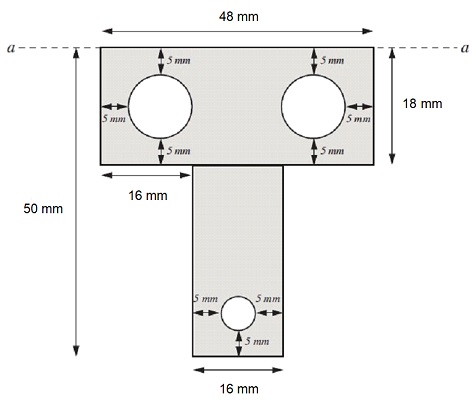
Figure 1
(ii) Determine the second moment of area of this shape and hence its radius of gyration about the axis a-a.
Question 4 (a) What is the formula for calculating the pressure due to the height of liquid?
(b) Name two devices which make use of this formula when used for pressure measurement.
(c) (i) In the situation shown in Figure 2, calculate the pressure difference between points 1 and 2 for the flow of a gas within the pipe. The liquid present is mercury whose density is 13560 kgm-3.
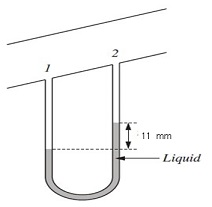
Figure 2
(ii) The liquid is now replaced by a new liquid whose density is 2200 kgm-3. If the pressure difference remains constant, what will be the new difference in level between each limb?
(iii) What is the advantage of changing the liquid?
Question 5 A storage tank has the cross-sectional shape shown in Figure 3 and is of 1.2 m breadth. Calculate the resultant force acting on the inclined surface AB and its point of action.
The density of the liquid is 950 kgm-3 and take g = 9.81 ms-2.
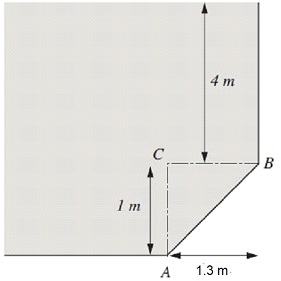
Figure 3
Question 6 (a) Describe the operation of a device which uses hydraulic pressure.
(b) Define:
(i) force ratio;
(ii) movement ratio.
(c) It is required to lift a skip whose load total is 18 kN. Two simple lifting jacks are available, both having an effort piston diameter of 12 mm and a load piston diameter of 80 mm. The load is to be distributed equally between the two. Calculate:
(i) the force ratio and movement ratio of each jack;
(ii) the pressure within the hydraulic fluid.
Question 7 The diagram shown below represents a process for which a pump and associated pipework require to be correctly sized.
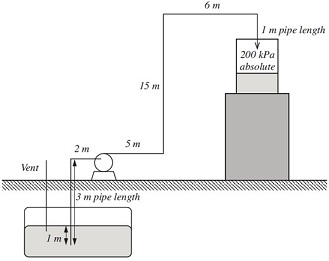
The liquid is to be pumped from the underground storage vessel which is vented to atmosphere (assume 1 bar pressure) to a pressurized container supported some distance above ground level. The pump is sited at ground level and must be capable of delivering 0.01 m s3 -1 with a maximum velocity of 1.8 ms-1.
Data:
Liquid density, ρ = 960 kgm-3
Liquid viscosity, μ = 0.081 Pas
(a) Calculate the theoretical diameter of the pipe; the nominal pipe diameter chosen from the table and the actual average velocity in the nominal pipe.
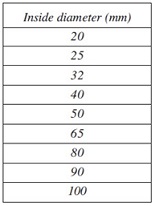
(b) Calculate Reynolds number for the process and hence the head loss due to friction. State any assumptions made.
(c) Using the following table for minor head losses, calculate the minor head losses for the system using both the equivalent length method and the number of velocity heads method. Compare the head losses estimated by each method.

(d) Calculate the head required for the pump and its power requirement assuming a 70% efficiency.
(e) If the same pump was later used to pump water from the lower reservoir to the upper reservoir, what flow rate of liquid could be achieved? (N.B. This may require an iterative solution).
` State any assumptions made.
Data:
Water density, ρ = 1000 kgm-3
Water viscosity, μ = 0.001 Pas